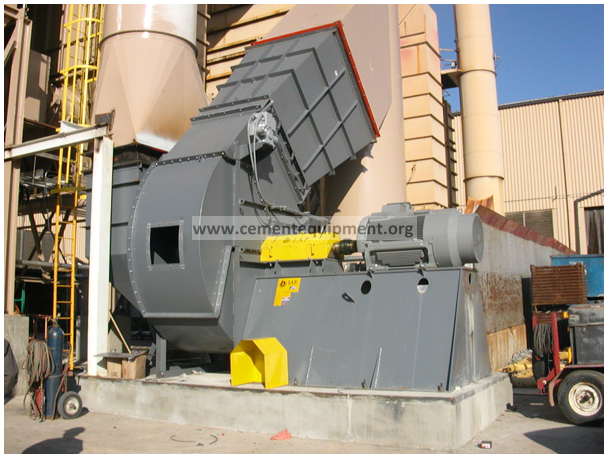Contents
Everything you need to know about Central and South American Standards and Specifications for Cements
[wpecpp name=”package” price=”75″ align=”center”]
by Jussara Tanesi*
Although Central and South American nations can be considered developing countries, they differ considerably from one to another, not only because of their diverse cultures and different languages, but also because of their particular economic and industrial development stage. For example, the per capita GDP (gross domestic production) ranged in 2001 from US $486 (Nicaragua) to US $7266 (Argentina)1, and urbanization ranged in 1999 from 36% (Guyana) to 90% (Argentina)2. The market, production, and characteristics of cement in this region vary too.
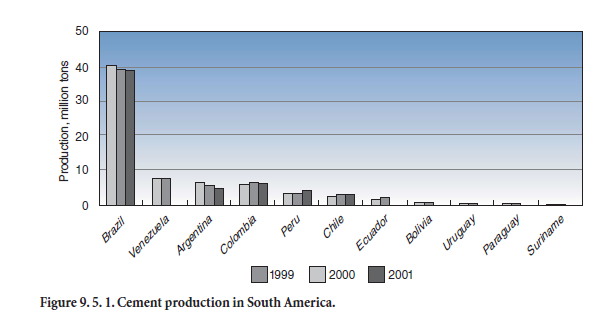
CEMENT MARKET3
Production and Consumption
Figures 9.5.1 and 9.5.2 display the annual cement production within the main cement producing countries in Central and South America. Brazil shows the highest production level (39 million tons in 2000) and Suriname the lowest (65,000 tons in 2000). South America accounted for 91% of the total production of Central and South America in 2000, where the main producers were Brazil (49%), Venezuela (10%), Colombia (9%), and Argentina (8%). The fact that the economies of those countries have been deteriorating in the last few years and has led
both production and per capita consumption to decrease since 1999, has to be taken into consideration as well. Production in Argentina has
diminished more than 22% in the period between 1999 and 2001. Nevertheless, the production in Peru, in the same period, increased by around 25%. In Central America the cement production increased 5% from 1999 to 2000. The only country that showed a drop in cement output was Costa Rica (8%).
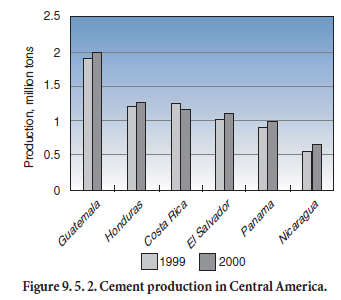
The following two charts display per capita cement consumption in South and Central American countries (Figure 9. 5. 3 and Figure 9. 5. 4). Although the per capita consumption and cement production within these countries are low when compared to the USA or Europe, cement is the most important construction material in South America. These numbers show the potential market for products related to cement when the national economies of this region expand and the construction industry grows. The demand for cement derives mainly from self-built projects and ready-mixed concrete companies. In Brazil, for example, the former accounts for 72% of consump-tion, while the latter accounts for 12%. Normally, the precast industry consumes less than 10% of the cement production.
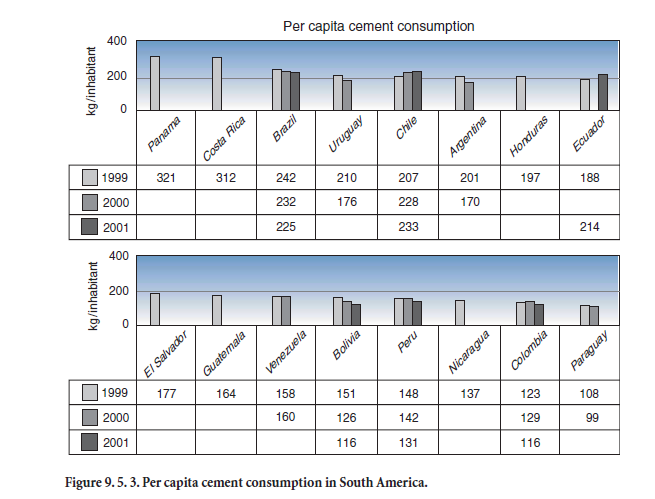
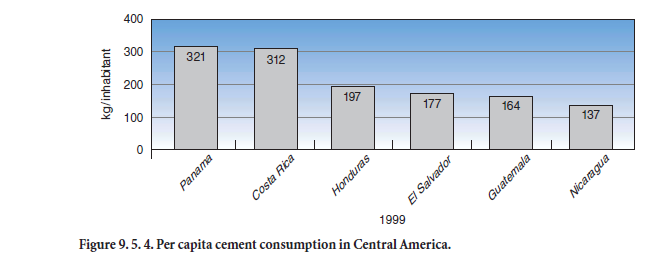
Cement Companies
The number of cement producers in South American countries average around five per country. Exceptions to this are Brazil which has 33 producers and 11 cement groups, and Colombia which has 10 producers. International groups are present in most of the Central and South American countries, excluding Bolivia, Paraguay, Peru, and Uruguay. In Bolivia, Nicaragua, Paraguay, and Uruguay, the state either partly or wholly owns the cement companies (International Cement Review, 2000).
Production Process
Central and South America cement productions have one clear aspect in common: the production process. The majority of the countries use dry process (Figure 9. 5. 5 and Figure 9. 5. 6). Only Colombia, Chile, Panama, and Nicaragua still have a considerable percentage of their installed capacity in the wet process. Even countries with relatively high poverty levels, such as El Salvador, Guatemala, and Honduras, do not produce cement by the wet process.
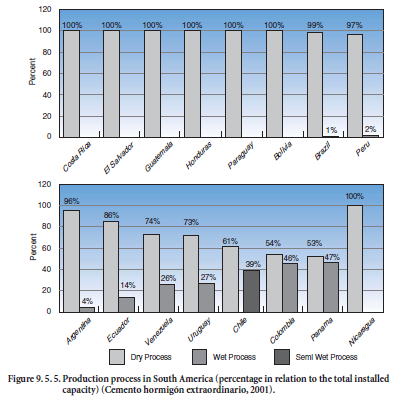
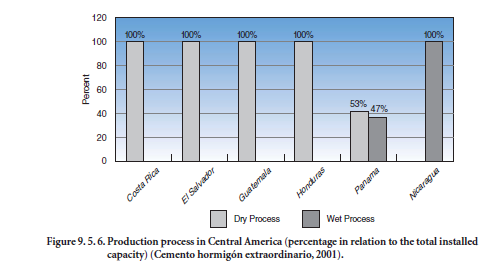
The use of dry process leads to higher energy efficiency. The installation of preheaters and precalciners can improve the efficiency of the kilns. In Central and South America, around 30% of the kilns have preheaters and 25% have precalciners. Brazil has the largest number of kilns with this equipment, with more than 30 preheaters and more than 20 precalciners. On top of that, most of the kilns are equipped with closed circuit mills and some have electrostatic precipitators. The average clinkering energy con-sumption in Brazil is 700-900 kcal/kg, in Bolivia 886 kcal/kg, and in Costa Rica 907 kcal/kg.
TYPES AND STANDARDS OF PORTLAND CEMENT
The main types of portland cement commercially available in Central and South America are shown by category in Table 9.5.1. The modified cements and the blended hydraulic products, are shown in Table 9.5.2 and Table 9.5.3, respectively. The types of cement which have national standards but are not commercially offered are not listed.
A larger number of cements are available than those shown in the tables. They present a combin-ation of special properties and requirements. The Argentinean market offers the pozzolanic hy-draulic cement that also brings alkali-aggregate resistance, low heat of hydration, and high sulfate resistance (ARS, BCH, RRAA); the CPN MRS (normal portland cement – moderate sulfate resist-ance); and the ARI MRS (high early strength – moderate sulfate resistance), all in agreement with IRAM 50000/2000 and IRAM 50001/2000.
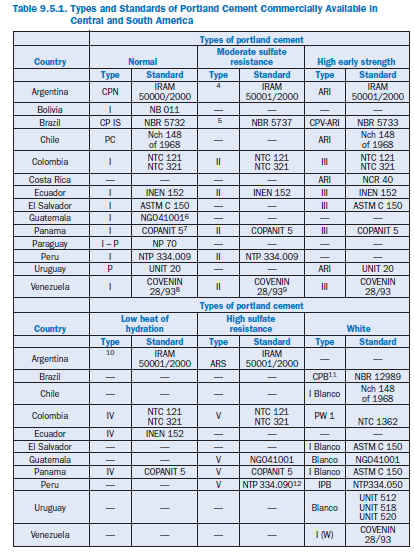
7 This cement follows the national standard COPANIT and the requirements in ASTM C 150, as well.
8 This cement follows the national standard COVENIN and the requirements in ASTM C 150, as well.
9 This cement follows the national standard COVENIN and the requirements in ASTM C 150, as well.
10 The low heat of hydration characteristic is available in Argentina in the pozzolan hydraulic cement.
11 In the structural white cement, 25% limestone addition is still allowed, while in the non-structural white cement, 26-
50% limestone addition is permitted.
12 This cement follows the national standard NTP and the requirements in ASTM C 150, as well.
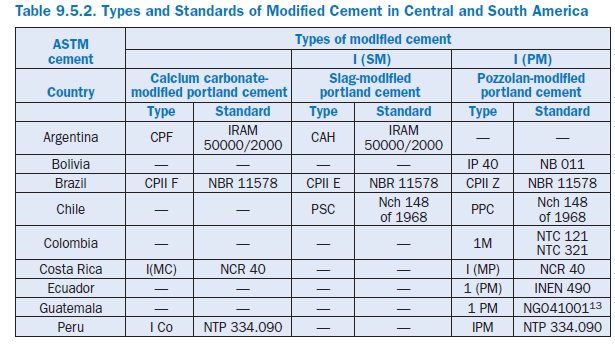
The Brazilian market offers a large variety of cements with combined properties: CPIIF RS (calcium carbonate-modified portland cement – sulfate resistance) and CPIIZ RS (pozzolan-modi-fied portland cement – sulfate resistance) according to NBR 11578 and NBR 5737; CPIII RS (port-land blast-furnace slag cement – sulfate resistance) following NBR 5735 and NBR 5737; the CPIV RS (portland-pozzolan cement – sulfate resistance) following NBR5736 and NBR 5737; and cement ARI RS (high early strength – sulfate resistance), according to NBR 5733 and NBR 5737.
In Chile, the PPARI (pozzolan-modified portland cement – high early strength) is available (Nch 148 of 1968). In Peru, cements I, II, and V can be found in the low-alkali content versions.
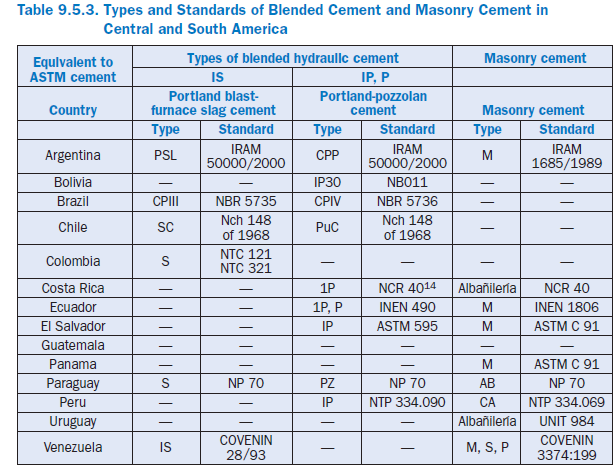
The use of more than one mineral addition is not unusual in the cements of the region. In Argentina, there is a CPC cement (blended cement) strength class 40 MPa, which has two or more fine materials (slag, pozzolan, and/or limestone), not exceeding 35% of the total cement’s mass, according to IRAM 50000/2000. El Salvador has two cements with pozzolan and limestone: a general purpose cement, strength class 28 MPa; and a cement designed exclusively for the fabrica-tion of blocks, strength class 29 MPa. Brazil has four types of cement in this condition (CPII E, CPII Z, CPIII, and CPIV) (Table 9.5.10 to Table 9.5.13).
The oil-well cements are produced by Argentina (Types G and H, following IRAM 1518 and API 10A), Brazil (Type G, following NBR 9831), Guatemala (Type H, following API 10A), and Venezuela (Types A, B, G, H, following API 10A).
Special purpose cements, such as for the production of fibrocement, are fabricated by Brazil, Chile, Costa Rica, and Paraguay and a cement for the construction of concrete pavements is produced by El Salvador.
South America produces a wider diversity of cements than Central America. Argentina and Brazil show the greatest variety of different types of cement, but still do not reach the variety found in the North American market. Cements such as ultrafine, expansive, water-repellent, ettringite, magnesium phosphate, and sulfur still are not available in Central and South America.
Some countries have adopted ASTM standards, while others have chosen to add some nationally focused modifications in order to adapt ASTM specifications to the properties of the local cement and to the respective national construction industries. Mercosur (Mercado común del sur), the South American community15, has created the AMN (Asociación Mercosur de normalización), the standards association for the Mercosur. Although the AMN has published the Mercosur standards for cements (NM), they are not widely used. The ICAITI (Central American Institute for Industrial Investigation and Technology) has created cement standards for Costa Rica, El Salvador, Guatemala, Honduras, and Nicaragua, but these countries prefer to use their national standards or, in some cases such as El Salvador, the ASTM standards.
SPECIFICATIONS
Table 9.5.4 to Table 9.5.13 display the standard specifications and the average values16 for strength, Blaine surface area, and setting time.
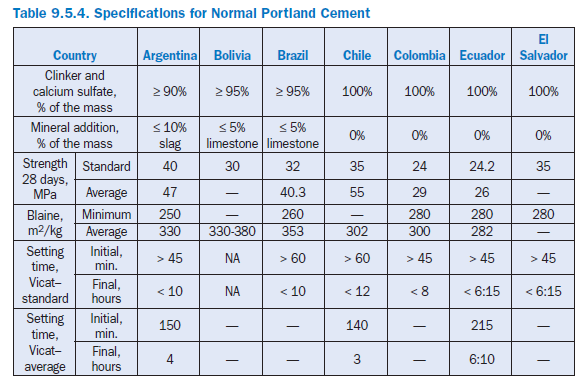
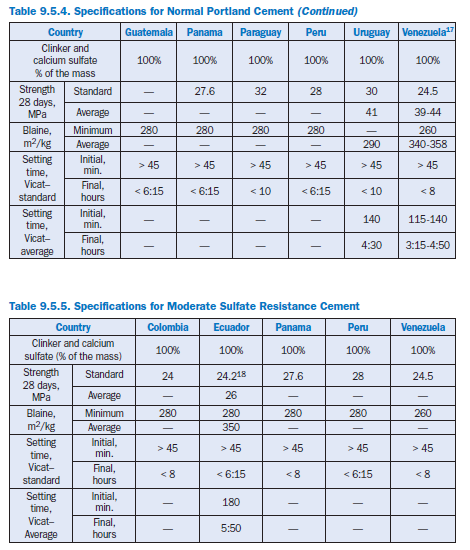
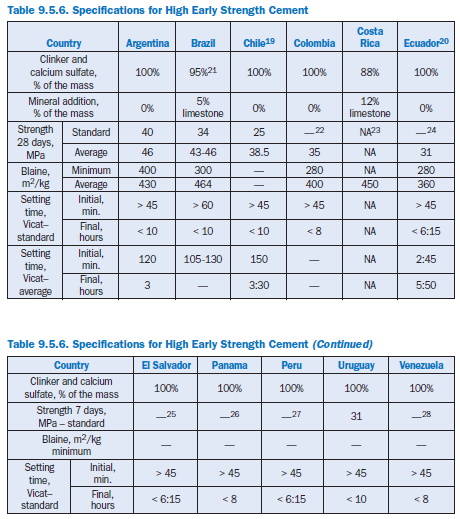
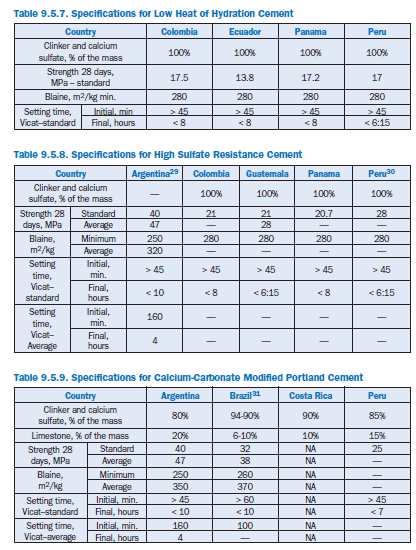
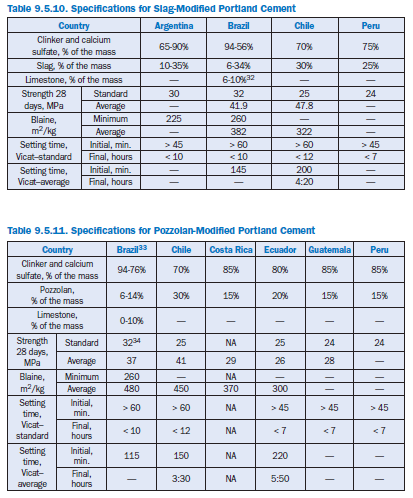
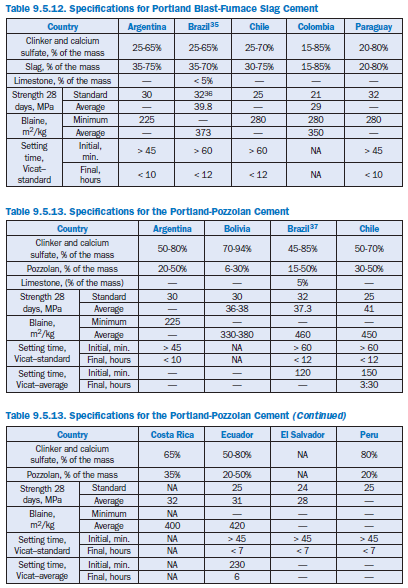
It can be observed that in some countries, such as Argentina, Bolivia, and Brazil, even normal port-land cement has small quantities of mineral additions. The average Blaine surface area is normally greater than 320 m2/kg. Cements from Argentina, Brazil, and Chile reach the highest strength (41–55 MPa in 28 days). The high early strength cement in those countries can reach 46 MPa in 7 days. The average strength in the market (when available) differs from that required by the stan-dards, from 18% (normal portland cement in Argentina) to 64% (portland-pozzolan cement in Chile). The data available regarding setting time shows that the initial setting time is approxi-mately 2 hours, around twice the standard specifications.
USES OF THE CEMENT
Normal Portland Cement
This is a general-purpose cement used when no special properties are required, except in Argentina and Colombia where this type of cement can be found with special properties, such as moderate sulfate resistance. This cement can be used in reinforced concrete, pavements, precast concrete products, masonry work, pre-stressed concrete, and post-tensioned concrete. In Argentina and Brazil, this cement has small quantities of other fine materials in its composition: a maximum of 10% slag and a maximum of 5% limestone, respectively.
Moderate Sulfate Resistance
Designed for concrete structures that need moderate sulfate resistance and/or when a low heat of hydration is required. Moderate sulfate resistance cement is recommended for building and indus-trial construction, bridges, structures exposed to soil and ground water with moderate sulfate concentration, or to sea water, or structures with a high volume of concrete. The C3A (tricalcium aluminate) is limited to 8%. In Argentina the average C3A content is as low as 5%.
High Early Strength
Normally this cement is known as ARI (Alta Resistencia Inicial). The high early strength usually is due to the high Blaine surface area and not the C3A hydration product. The maximum C3A content is 15% when sulfate resistance is not required. The Blaine surface area is normally higher than 400 m2/kg. In most of the countries, this cement is composed of clinker and gypsum. However, in Costa Rica and Brazil, up to 12% and 5% of limestone is added, respectively. This cement is used in concrete structures which need high early strength, such as pavements (fast-track), precast concrete products, high performance concrete, concrete placed during cold weather, prestressed concrete, and post-tensioned concrete. This cement represents 7.7% of the total national cement market in Brazil and 5% in Costa Rica.
Low Heat of Hydration
This cement is used when low heat of hydration is needed, such as in massive concrete. As the C3A (tricalcium aluminate) and the C3S (tricalcium silicate) produce heat during their hydration, the content of these chemical compounds is limited to a maximum of 7% and 35%, respectively.
High Sulfate Resistance
This cement is used when the structure will be in contact with environments with high soluble sulfate concentrations, such as foundations in aggressive soil, pavements, structures in contact with sea water, industrial plants, and water or sewage treatment plants. In Argentina the maximum C3A permitted is 4%, while in the other countries it is 5%.
White Cement
This cement is used in precast concrete elements, architectural concrete, floors, and façade finishing.
Modified Portland Cement
These types of cement have small amounts of fine material ground with the clinker and are used as general purpose cement, when the concrete does not need to develop high early strength. In order to compensate for some property modifications (development rate of strength, setting time), these cements have a higher Blaine surface area.
Calcium carbonate-modified portland cement is similar to normal portland cement, and used for the same purpose. They differ because the modified version carries small amounts of calcium carbonate in it. For this type of cement,a maximum of 10% of limestone can be added in Brazil and Costa Rica, whereas in Argentina a maximum of 20% is allowed.
Slag-modified portland cement is produced by intergrinding slag and portland cement clinker. Argentina accepts the highest amount of slag (35%), followed by Brazil (34%), Chile (30%), and Peru (20%). In Brazil, 10% limestone is interground with the slag and clinker.
Pozzolan-modified portland cement has small amounts of pozzolan in its composition. In Brazil, the total amount of clinker varies from 76% to 94%, as 14% of pozzolan and 10% of lime-stone are tolerated. In Chile, the content of pozzolan can reach 30%, whereas in the other coun-tries this amount is less than 20%.
Blended Hydraulic Cements
An arbitrary difference between modified cements and blended cements is that the higher content of mineral additions in the blended version influences the main properties of the resulting concrete: less heat of hydration, slower strength development, lower permeability, and improved durability.
Portland blast-furnace slag cement can be used for general construction when alkali-aggre-gate resistance is necessary, or when low permeability or low heat of hydration are desired, such as in dams and massive concrete. In Colombia, addition of 85% blast-furnace slag is permitted; this amount is 80% in Paraguay, and 75% in Argentina and Chile. In the other countries no more than 70% is allowed.
Portland-pozzolan cement is used in concretes subjected to severe conditions, such as sulfate exposure, as well as when potentially reactive aggregates are used. Concrete exposed to sea water and precast concrete subjected to thermal curing are examples that use this kind of blended cement.
ENVIRONMENT
In the last few years, the cement industry all over the world has been trying to implement strategies and technologies in order to diminish the environmental impact caused by cement production. Central and South America strive to achieve the goals of quality-economy-environment through the four following actions:
• The energy consumption can be reduced in the production process by the use of dry process, preheaters, and precalciners, as discussed in the Production Process section.
• The use of mineral additions in substitution of part of the clinker content helps the sustainable development in three ways. First, the less clinker that has to be produced, the less energy con-sumed, and the lower the CO2 emission in the atmosphere. The substitution of 50% of clinker by slag can reduce energy consumption by 40% (John, 2002). Second, the less clinker used, the longer the service life of the quarries. Third, the use of waste materials in the production of blended cement and modified cement helps to reduce the areas necessary for material disposal.
In Costa Rica all the types of cement have mineral additions. In Brazil38, 76% of the cement consumption uses modified cements and 15% uses blended cements. Nowadays, in this country, 13 million tons of slag and 1.1 millions tons of fly ash are consumed annually, preserving 17.6 million tons of limestone and 3.5 million tons of clays (Kihara, 1999).
• The efficiency of the filters plays a big role in the emission and powder control. Countries such as Argentina, Brazil, El Salvador, and Peru have been investing in the installation of electrostatic precipitators which have 99% efficiency. For example, Argentina has spent around $80 million in the last five years towards this effort. It is estimated that in Peru and in Brazil, 20% and 15%of the production cost, respectively, is related to pollution control. The CO2 emission in Brazil is around 600 kg/ton (John, 2002), in Costa Rica39 960 kg/ton, and in El Salvador40 700 kg/ton.
• El Salvador, Guatemala, Honduras, Nicaragua, Panama, Paraguay, and Uruguay still widely use fuel oil. Colombia, Chile, and Peru prefer to use coal, while Costa Rica and Brazil utilize pet coke as the main fuel. Nevertheless, interest in coprocessing wastes, such as tires and recycled oils, is increasing gradually. In Brazil, it is estimated that 200,000 tons of residues per year are employed in nine plants (Engenharia, Ciência e Tecnologia, 2001) – and it is expected that 30% of the fuel will be coprocessed materials, which could reach 400,000 tons per year at some point (Kihara, 1999). In Argentina, some plants replace 20% of the fuel with alternate fuels, and in Chile, some place around 30%.
REFERENCES
Cemento Hormigón Extraordinario, Información sobre la industria del cemento en Latinoamérica, No. 830, Spain, 2001, pages 1257-1301.
Engenharia, Ciência e Tecnologia, Cimento e meio ambiente, Vol. 4, No..3, São Paulo, May-June, 2001, pages 17-22.
European Cement Association, Cement Standards of the World, Brussels, 1991.
International Cement Review, Global Cement Report, Surrey, U.K., 2000.
John, V., Construção e o meio ambiente, www.reciclagem.pcc.usp.br/a_construcao_e.htm
Kihara, Y., “Co-processamento de resíduos em fornos de cimento: Tendências,” II Seminário desen-volvimento Sustentável e a Reciclagem na Construção Civil – Proceedings, June, São Paulo, 1999, pages 35-43.
